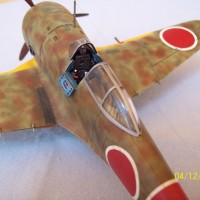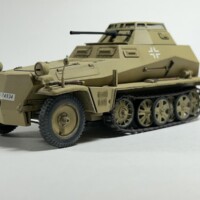1/48 Hasegawa Ki-44-II Hei “Tojo”
Aircraft flown by Capt. Wakamatsu 85th Sentai Canton, China, summer 1944. Jaguar resin cockpit was the only aftermarket used. Additional detail to the engine in the form of wiring was done as well as brake lines. Reference for the color scheme was the excellent book by Nickolas Millman the "Ki-44 Aces of World War 2".



















Excellent work ! I like it... a LOT 🙂
Each time I take another look at it, I notice something new.
Well done...
"liked'
simply gorgeous
Stunning, Dale!
A real beauty!
You did a fantastic job here. Working on one at the moment myself
🙂 … Greetings … 🙂 :
Very nice job on this model Dale, that paint scheme is one that sets it apart.
Outstanding work Dale, love that camo scheme.
I like this unusual camo scheme. Credit Nick Millman for finding the photos, and Ronnie Olshoorn for realizing the profiles from the information provided. This really makes the model "pop."
There's one thing that may need more research to fully determine, but in the last 10 years or so (thanks to the Sen-sei at J-aircraft.com), it's become clear that the "traditional" thought of Japanese interiors being variations of the "clear" green and blue paint are right down there with the old rule (up to the mid-70s) that "All German planes are two shades of green on top and light blue beneath." It turns out the various manufacturers had their own interior colors (as did ours, it's now known). Nakajima's color was something very close to "classic" US Interior Green. I saw it on the PoF Zero (which was Nakajima-built) which they disassembled and stripped down to bare metal then repainted. The cockpit still had the factory-original paint, which they photographed and matched. It's still unclear if this was carried through on IJAAF as well as IJNAF, but given the way things were produced, it's highly likely that interiors were the same across the services. (Information provided for further research into the never-ending topic What Color Were Japanese Airplanes Anyway?)
The gentleman you mentioned, Nick Millman has written otherwise about the colors used on this Ki-44 type. Here are his color choices verbatim.
"I would have no hesitation in using it as the basis for painting a Shoki cockpit. In fact my own pecking order, included for interest rather than mandated in any way, would be as follows:-
Dark blue-grey, # 3, for early and mid-production examples
Yellowish olive green, # 29 for mid-production to late-production examples
Olive drab, # 7, for late production examples
Translucent yellow-green aotake as a possibility on some mid-war examples.
Blue aotake."
There are no surviving examples of this plane left in the world to anyone's knowledge. There may still be some undiscovered wrecks located in the future, but all of the "known" examples are now beer cans and extension ladders, since all of the "known" surviving examples have been smelted down a long time ago.
A lot of new information has become available over the past few years. There have been many people working on this subject, both Japanese and American aviation historians.
Here's a link to the article that covers this in depth. There are even color samples digitally provided by these persons...
http://www.aviationofjapan.com/2009/11/useful-colours-army-interiors-part-two.html
I suggest you go take a look, and see for yourself.
This way we can stop promoting ideas that once were once touted as "historically" accurate, but have now been deemed otherwise.
Thanks.
Yes Louis, this is the same article I used as color documentation on the Ki-44's cockpit. Thanks for posting it!
Thanks for the information Tom. You would be 100% correct if the cockpit and wheel well color on the model represented aotake. It does not. I'm aware of the fact very few if any cockpits on Japanese WWII planes were done in aotake. The color I used represents Hai-Ai-Iro or literally ash blue color i.e. grey blue. This color was a close approximation to RLM24. According to the reference I used "stragglersearch.com", this color was known to be applied to cockpits of Nakajima Type 91, Ki-27, Ki-21, Ki-36, Ki-43, Ki-44, and Ki-48. Yes, green was also used on Ki-44 cockpits.
Thanks everyone for the comments!
I really like that scheme! I've got a couple of these, and am going to have to use this scheme on one. Is the underlying color the grey-blue from the bottom and cowl lip? It appears so, but wanted to make sure it wasn't NMF.
And that's a beautiful build - really looks great - well done.
By the way - if you use a modeler's iModeler handle (like this: @dtravis), they will see your comment without having to remember to come back to the page. Thus in your response to Tom C above, he may not see your comment unless you included his iM handle.
Thanks Greg. The book I used as a reference stated some of the Ki-44's that were originally delivered in natural metal were painted overall blue-grey and actually flew some missions in this scheme. Then the brown/green was applied over the blue-grey upper surfaces.
Great build Dale. Well don and as others have stated-excellent paintwork.
Thanks Clark!
I will jump in and echo the others - nice paintjob! I like your build quite a bit. Hasegawa's Japanese fighters done around this time are really excellent - I believe the Ki84 came out around the same time, and is just as detailed. great OOB kits, and excellent painting like yours makes them shine! Nice work!
Thanks very much Paul!